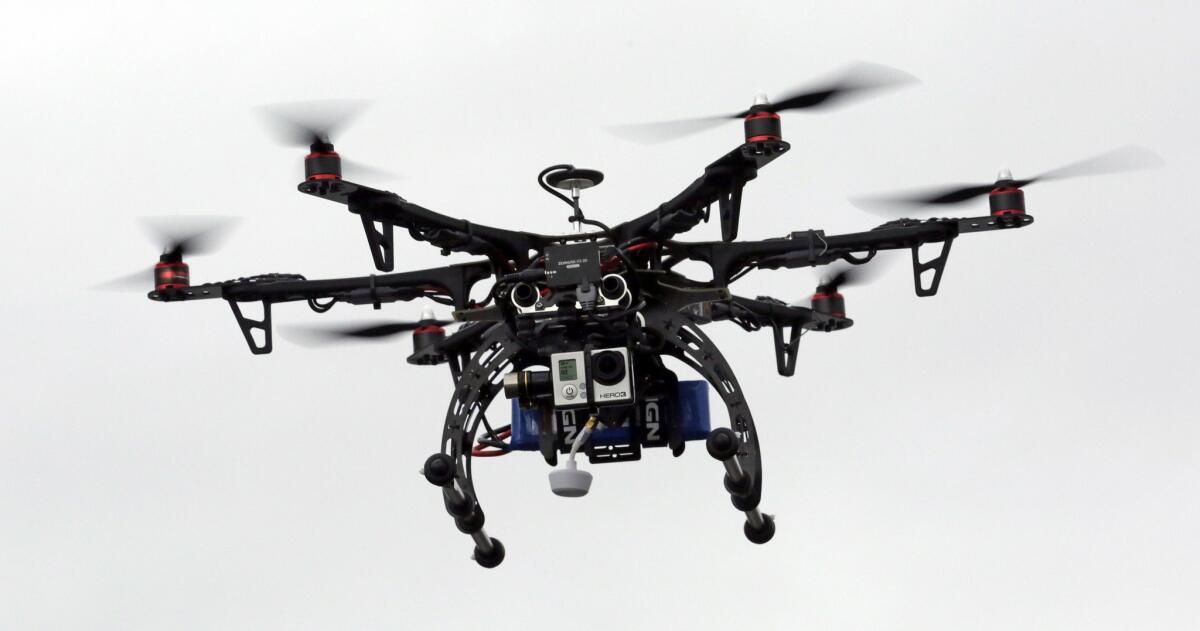Editorial: Drone regulations should be considered for use now and in the future

A drone is demonstrated in Brigham City, Utah, on Feb. 13, 2014.
The demand for recreational drones grew shockingly fast this year, catching much of the country unaware — and unprepared. Once the price for a camera-equipped quadcopter dropped below $100, the aerial robots started flying off the shelves. Seemingly overnight, every major retailer had a drone model for sale. Even Macy’s.
The allure of recreational drones (formally known as unmanned aircraft systems) is that they use sophisticated technology that requires little or no training to operate. Not surprisingly, as sales climbed, so did the reports of mishaps and disruption. Out of control personal drones crashed into things and people — including a baby girl in a stroller who was hit by a 6-pound drone in September while her mother pushed her along a Pasadena street. In the U.S., amateur operators blundered into restricted airspace with terrifying regularity, coming too close to passenger airplanes and disrupting aerial firefighting operations. In October, a drone hit power lines in West Hollywood, knocking out power to hundreds of people.
Right now, commercial drone operators must have a pilot’s license to fly, while recreational ones aren’t even required to read the manual. That has to change.
Local, state and federal authorities have responded with regulations aimed at keeping drones from being a dangerous nuisance. It’s good they are now paying attention. About 400,000 drones are expected to be sold in the U.S. this holiday season, more than half of all the drones that will be sold all year. Next year is expected to be an even bigger one for recreational drone sales.
That’s reason enough for regulation, but unmanned aircraft technology is not a fad that will cool off once every household has a personal drone parked in the garage. Businesses are dying to use drones and will do so in a big way as soon as the Federal Aviation Administration lifts its blanket ban on commercial drone use and releases new rules next year. Currently, the FAA allows such uses only if the drone operator has a special permit. About 2,500 of those permits have been issued; tellingly, all but a few of them have been issued this year.
Meanwhile, Amazon, Google X and other companies are planning to use drones for package delivery as soon as 2017 — an advancement that would require a system of low-altitude highways for unmanned aircraft through every state and community. A video released by Amazon recently shows a Prime Air delivery drone flying between 200 and 400 feet above the ground — a place that until now humanity has left mainly to the birds.
Authorities must get in front of these issues, but not so far ahead and afield as to stifle this new and transformative technology.
The immediate need is to craft reasonable rules to rein in the mass of recreational drones. The FAA and industry executives are developing a registration system that could help identify the owners of wayward drones. That’s good, but not enough. The feds must also consider requiring the operators of heavier drones to be trained and certified. Right now, commercial drone operators must have a pilot’s certificate to fly, while recreational ones aren’t even required to read the manual. That has to change. These may be toys, but they are large enough to stop a firefighting operation and inflict an injury.
Congress should also support a proposal by Sen. Dianne Feinstein (D-Calif.) to require drone manufacturers to install GPS-based geofencing technology to stop drones from operating in restricted areas and flying higher than permitted. It would address the biggest public safety threats of recreational drones: running into planes, crashing into crowded events or delivering weapons and drugs to prison yards. (Yes, that has happened.) Drone manufacturer DJI installs geofencing in its popular commercial drones. The company plans to upgrade this feature next year so that qualified users can unlock the default geofencing and self certify to fly in some restricted areas. This approach would accommodate expert operators while creating a paper trail and accountability should something go wrong. This could be a model for the entire industry.
State and local officials need to start outlining rules for where and how people can operate drones, taking care not to overstep their authority or give in to headline-induced hysteria. In 2015, after several highly publicized mishaps, California lawmakers rushed in with a number of drone bills. Gov. Jerry Brown vetoed them. He had sound reasons: The bills tried to regulate airspace, over which the FAA has sole jurisdiction, or they opened up recreational users to unreasonable lawsuits. The challenge for California and other states in 2016 is to write regulations that balance public safety against the numerous benefits of drones, while laying the groundwork for incorporating this technology in its future iterations into daily life. Banning drones outright shouldn’t be an option.
In coming months, the National Conference of State Legislatures will release a set of best practices to help guide states as they regulate drone use. That’s a good place for lawmakers to start. Cities and communities, meanwhile, would be smart to identify where they’d like residents to operate or not operate drones, then develop “drone zones.”
Meanwhile, the discussion should begin now about the bigger questions raised by the generations of drones to come. Are existing privacy laws sufficient for this new technology? How do we manage low-altitude traffic so that the space above our roofs doesn’t turn into a robot-choked mess? How will sky highways affect birds and wildlife? Are drones that carry humans coming next?
The first wave of drones hit with little warning. Let’s be prepared for the next one.
Follow the Opinion section on Twitter @latimesopinion and Facebook.
More to Read
A cure for the common opinion
Get thought-provoking perspectives with our weekly newsletter.
You may occasionally receive promotional content from the Los Angeles Times.










